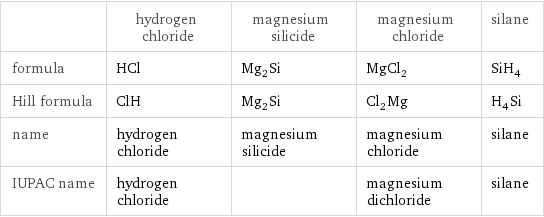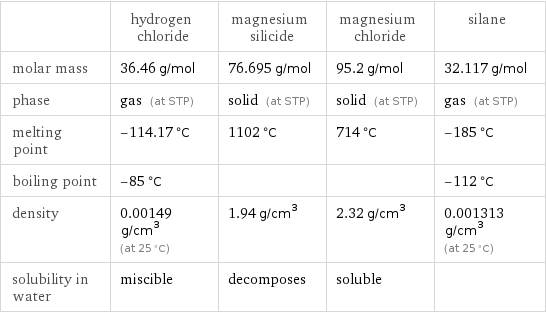Input interpretation

HCl hydrogen chloride + Mg_2Si magnesium silicide ⟶ MgCl_2 magnesium chloride + SiH_4 silane
Balanced equation

Balance the chemical equation algebraically: HCl + Mg_2Si ⟶ MgCl_2 + SiH_4 Add stoichiometric coefficients, c_i, to the reactants and products: c_1 HCl + c_2 Mg_2Si ⟶ c_3 MgCl_2 + c_4 SiH_4 Set the number of atoms in the reactants equal to the number of atoms in the products for Cl, H, Mg and Si: Cl: | c_1 = 2 c_3 H: | c_1 = 4 c_4 Mg: | 2 c_2 = c_3 Si: | c_2 = c_4 Since the coefficients are relative quantities and underdetermined, choose a coefficient to set arbitrarily. To keep the coefficients small, the arbitrary value is ordinarily one. For instance, set c_2 = 1 and solve the system of equations for the remaining coefficients: c_1 = 4 c_2 = 1 c_3 = 2 c_4 = 1 Substitute the coefficients into the chemical reaction to obtain the balanced equation: Answer: | | 4 HCl + Mg_2Si ⟶ 2 MgCl_2 + SiH_4
Structures

+ ⟶ +
Names

hydrogen chloride + magnesium silicide ⟶ magnesium chloride + silane
Equilibrium constant
![Construct the equilibrium constant, K, expression for: HCl + Mg_2Si ⟶ MgCl_2 + SiH_4 Plan: • Balance the chemical equation. • Determine the stoichiometric numbers. • Assemble the activity expression for each chemical species. • Use the activity expressions to build the equilibrium constant expression. Write the balanced chemical equation: 4 HCl + Mg_2Si ⟶ 2 MgCl_2 + SiH_4 Assign stoichiometric numbers, ν_i, using the stoichiometric coefficients, c_i, from the balanced chemical equation in the following manner: ν_i = -c_i for reactants and ν_i = c_i for products: chemical species | c_i | ν_i HCl | 4 | -4 Mg_2Si | 1 | -1 MgCl_2 | 2 | 2 SiH_4 | 1 | 1 Assemble the activity expressions accounting for the state of matter and ν_i: chemical species | c_i | ν_i | activity expression HCl | 4 | -4 | ([HCl])^(-4) Mg_2Si | 1 | -1 | ([Mg2Si])^(-1) MgCl_2 | 2 | 2 | ([MgCl2])^2 SiH_4 | 1 | 1 | [SiH4] The equilibrium constant symbol in the concentration basis is: K_c Mulitply the activity expressions to arrive at the K_c expression: Answer: | | K_c = ([HCl])^(-4) ([Mg2Si])^(-1) ([MgCl2])^2 [SiH4] = (([MgCl2])^2 [SiH4])/(([HCl])^4 [Mg2Si])](../image_source/2bea2b0f1f414d24cf4c940f0801d125.png)
Construct the equilibrium constant, K, expression for: HCl + Mg_2Si ⟶ MgCl_2 + SiH_4 Plan: • Balance the chemical equation. • Determine the stoichiometric numbers. • Assemble the activity expression for each chemical species. • Use the activity expressions to build the equilibrium constant expression. Write the balanced chemical equation: 4 HCl + Mg_2Si ⟶ 2 MgCl_2 + SiH_4 Assign stoichiometric numbers, ν_i, using the stoichiometric coefficients, c_i, from the balanced chemical equation in the following manner: ν_i = -c_i for reactants and ν_i = c_i for products: chemical species | c_i | ν_i HCl | 4 | -4 Mg_2Si | 1 | -1 MgCl_2 | 2 | 2 SiH_4 | 1 | 1 Assemble the activity expressions accounting for the state of matter and ν_i: chemical species | c_i | ν_i | activity expression HCl | 4 | -4 | ([HCl])^(-4) Mg_2Si | 1 | -1 | ([Mg2Si])^(-1) MgCl_2 | 2 | 2 | ([MgCl2])^2 SiH_4 | 1 | 1 | [SiH4] The equilibrium constant symbol in the concentration basis is: K_c Mulitply the activity expressions to arrive at the K_c expression: Answer: | | K_c = ([HCl])^(-4) ([Mg2Si])^(-1) ([MgCl2])^2 [SiH4] = (([MgCl2])^2 [SiH4])/(([HCl])^4 [Mg2Si])
Rate of reaction
![Construct the rate of reaction expression for: HCl + Mg_2Si ⟶ MgCl_2 + SiH_4 Plan: • Balance the chemical equation. • Determine the stoichiometric numbers. • Assemble the rate term for each chemical species. • Write the rate of reaction expression. Write the balanced chemical equation: 4 HCl + Mg_2Si ⟶ 2 MgCl_2 + SiH_4 Assign stoichiometric numbers, ν_i, using the stoichiometric coefficients, c_i, from the balanced chemical equation in the following manner: ν_i = -c_i for reactants and ν_i = c_i for products: chemical species | c_i | ν_i HCl | 4 | -4 Mg_2Si | 1 | -1 MgCl_2 | 2 | 2 SiH_4 | 1 | 1 The rate term for each chemical species, B_i, is 1/ν_i(Δ[B_i])/(Δt) where [B_i] is the amount concentration and t is time: chemical species | c_i | ν_i | rate term HCl | 4 | -4 | -1/4 (Δ[HCl])/(Δt) Mg_2Si | 1 | -1 | -(Δ[Mg2Si])/(Δt) MgCl_2 | 2 | 2 | 1/2 (Δ[MgCl2])/(Δt) SiH_4 | 1 | 1 | (Δ[SiH4])/(Δt) (for infinitesimal rate of change, replace Δ with d) Set the rate terms equal to each other to arrive at the rate expression: Answer: | | rate = -1/4 (Δ[HCl])/(Δt) = -(Δ[Mg2Si])/(Δt) = 1/2 (Δ[MgCl2])/(Δt) = (Δ[SiH4])/(Δt) (assuming constant volume and no accumulation of intermediates or side products)](../image_source/630405310a24c923fadd537e400ce27a.png)
Construct the rate of reaction expression for: HCl + Mg_2Si ⟶ MgCl_2 + SiH_4 Plan: • Balance the chemical equation. • Determine the stoichiometric numbers. • Assemble the rate term for each chemical species. • Write the rate of reaction expression. Write the balanced chemical equation: 4 HCl + Mg_2Si ⟶ 2 MgCl_2 + SiH_4 Assign stoichiometric numbers, ν_i, using the stoichiometric coefficients, c_i, from the balanced chemical equation in the following manner: ν_i = -c_i for reactants and ν_i = c_i for products: chemical species | c_i | ν_i HCl | 4 | -4 Mg_2Si | 1 | -1 MgCl_2 | 2 | 2 SiH_4 | 1 | 1 The rate term for each chemical species, B_i, is 1/ν_i(Δ[B_i])/(Δt) where [B_i] is the amount concentration and t is time: chemical species | c_i | ν_i | rate term HCl | 4 | -4 | -1/4 (Δ[HCl])/(Δt) Mg_2Si | 1 | -1 | -(Δ[Mg2Si])/(Δt) MgCl_2 | 2 | 2 | 1/2 (Δ[MgCl2])/(Δt) SiH_4 | 1 | 1 | (Δ[SiH4])/(Δt) (for infinitesimal rate of change, replace Δ with d) Set the rate terms equal to each other to arrive at the rate expression: Answer: | | rate = -1/4 (Δ[HCl])/(Δt) = -(Δ[Mg2Si])/(Δt) = 1/2 (Δ[MgCl2])/(Δt) = (Δ[SiH4])/(Δt) (assuming constant volume and no accumulation of intermediates or side products)
Chemical names and formulas

| hydrogen chloride | magnesium silicide | magnesium chloride | silane formula | HCl | Mg_2Si | MgCl_2 | SiH_4 Hill formula | ClH | Mg_2Si | Cl_2Mg | H_4Si name | hydrogen chloride | magnesium silicide | magnesium chloride | silane IUPAC name | hydrogen chloride | | magnesium dichloride | silane
Substance properties

| hydrogen chloride | magnesium silicide | magnesium chloride | silane molar mass | 36.46 g/mol | 76.695 g/mol | 95.2 g/mol | 32.117 g/mol phase | gas (at STP) | solid (at STP) | solid (at STP) | gas (at STP) melting point | -114.17 °C | 1102 °C | 714 °C | -185 °C boiling point | -85 °C | | | -112 °C density | 0.00149 g/cm^3 (at 25 °C) | 1.94 g/cm^3 | 2.32 g/cm^3 | 0.001313 g/cm^3 (at 25 °C) solubility in water | miscible | decomposes | soluble |
Units
